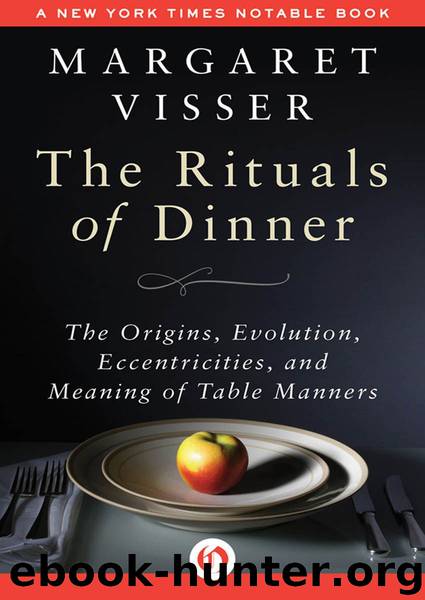The Rituals of Dinner by Visser Margaret

Author:Visser, Margaret
Language: eng
Format: epub
ISBN: 978-1-5040-1169-3
Publisher: Open Road Media
Published: 2015-06-23T04:00:00+00:00
HELPINGS
We no longer eat from a common dish, but are each served, or each take, a portion on a plate. Seated upright on our separate chairs, we keep elbows in and hands off anybody else’s dish. It was once a friendly gesture to give fellow diners choice morsels from our plates or from serving dishes set near us on the table, or for the host to express esteem for particular guests by passing them special delicacies. It is now permissible only where there is considerable intimacy for fellow diners to give each other “tastes” from their plates. Correct behaviour guarantees the absolute sovereignty of every diner over his or her domain: the individual plate in its designated “place,” an area of the table safely bordered by its metal implements and impermeable to incursions from without, except for supplies and replenishments of food as permission for these is given.
The “place,” at formal dinners still, is never permitted to stand empty. On entering the dining room, and nowadays on entering many an expensive restaurant, the prospective diner finds a “place plate,” and upon it a napkin, filling the area of the “place.” (If there is no place plate, a compromise may be made by having the napkin alone fill this space.) A place plate is often elaborate: it never has to submit to scraping and scrubbing, for it is never used for actual eating. It has no function but to ensure that the designated area does not lie empty; it will be removed when food is brought in. As each succeeding course is finished and the dishes are taken away, a clean place plate should always fill every place until the next course arrives—“A plate with food on it can never be exchanged for a plate that has had food on it; a clean one must come between.” It is as though these patches of bare tablecloth cry out to be filled, like guests who must not be left unsatisfied lest they become “demanding” and a source of future trouble.
A place is not a place at a formal dinner without its plate. Formal etiquette is said to require that, when a very correct diner eats alone, four places should be laid, one at each of the table’s four sides, and four even at a round table. Emily Post’s 1928 edition shows a picture of such a table laid for the lady of the house lunching alone. The objects customarily found on the dining-room table at meals, such as places laid for other people, or side plates even when no bread and butter is being served, are often necessary to a diner’s sense of well-being. An extreme example of this principle was the decision of the Igbo of Nigeria in the nineteenth century, made in a time of famine so serious that no coco-yam fufuu was available, and the people had to content themselves with soup. At the left-hand side of each diner, where comforting balls of fufuu would have been heaped up
Download
This site does not store any files on its server. We only index and link to content provided by other sites. Please contact the content providers to delete copyright contents if any and email us, we'll remove relevant links or contents immediately.
A Court of Wings and Ruin by Sarah J. Maas(7651)
The Death of the Heart by Elizabeth Bowen(3552)
The Sprouting Book by Ann Wigmore(3543)
Better Homes and Gardens New Cookbook by Better Homes & Gardens(3525)
BraveTart by Stella Parks(3395)
Salt, Fat, Acid, Heat: Mastering the Elements of Good Cooking by Nosrat Samin(3108)
Sauces by James Peterson(3051)
Kitchen confidential by Anthony Bourdain(3009)
The Bread Bible by Rose Levy Beranbaum(3004)
Classic by Mary Berry(2942)
Solo Food by Janneke Vreugdenhil(2929)
Ottolenghi - The Cookbook by Yotam Ottolenghi(2871)
Martha Stewart's Baking Handbook by Martha Stewart(2796)
Day by Elie Wiesel(2720)
Betty Crocker's Good and Easy Cook Book by Betty Crocker(2681)
The Plant Paradox by Dr. Steven R. Gundry M.D(2547)
My Pantry by Alice Waters(2546)
The Kitchen Counter Cooking School by Kathleen Flinn(2487)
Hot Sauce Nation by Denver Nicks(2451)
